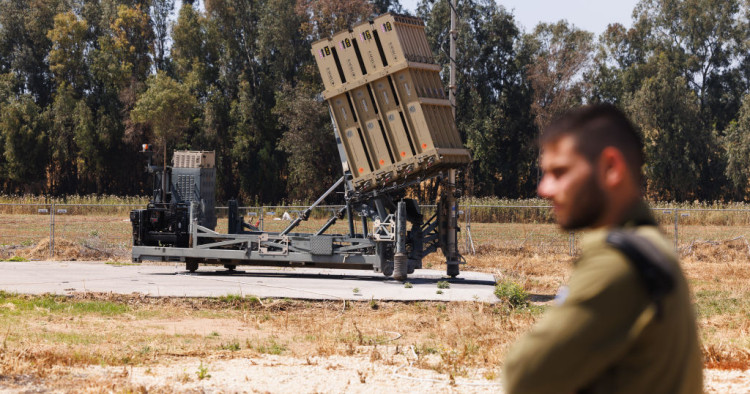Contents:
- In the Israel-Iran standoff, it’s not about direct deterrence
- Understanding Turkey’s recent diplomatic shift and hardening pro-Hamas rhetoric
- Congressional aid package gives the Biden administration more tools and leverage in Middle East policy
- Palestinian statehood bid fails at the UN because of US veto
- Climate change continues to afflict the Middle East, as extreme weather floods the Arabian Peninsula and surrounding regions
- Pakistan’s anti-establishment opposition counterattacks
In the Israel-Iran standoff, it’s not about direct deterrence
Eran Etzion
Non-Resident Scholar

-
In their direct attacks on one another, both Iran and Israel referred to the need to preserve their “deterrence” against the other side; yet in fact, the two countries had never been able to truly deter each other.
-
The right prism through which to examine Iran and Israel’s open exchanges of missile and drone attacks is not the bilateral Iran-Israel lens but rather the triangle of US-Iran-Israel relations.
The world watched with amazement as hundreds of missiles, drones, and interceptors clashed in the skies above Israel — like a scene straight out of Star Wars. Then it awaited the Israeli response, while trying to persuade Israel to “take the win.” The Israeli government, reportedly due to heavy pressure from the United States, ultimately decided to send a “strategic signal” in the shape of an attack on an Iranian S-300 air-defense radar protecting the Natanz nuclear facility. In justifying their respective actions, both Israel and Iran used very similar language — that of deterrence. Each side claimed it had been “pushed into a corner” and could not allow the other side’s attack to go unpunished, which would have compromised its vaunted “deterrence.” The facts, however, tell a different, less convenient story for both.
Iran’s efforts at deterrence haven’t really shielded it from dozens of Israeli operations in the last two decades — from assassinations of nuclear scientists and Islamic Revolutionary Guard Corps (IRGC) commanders to the theft of its nuclear archive and even the destruction of a military drone factory. On Iranian soil, as well as inside Syria and possibly also in Iraq and other countries, offensive Israeli actions largely hollowed out the Islamic Republic’s deterrence. Iran, for its part, continued fortifying and tightening the “noose” it was attempting to place around Israel, building Hezbollah into a formidable army, arming the Palestinian Islamic Jihad, training and financing Hamas, as well as expanding support for its allied militias in Syria, Iraq, and Yemen. As far as Tehran was concerned, there was in effect no Israeli “deterrence” in Gaza nor in Syria. Until a little over a week ago, Iran did avoid direct attacks on Israel’s soil; but this was clearly part of a calculated “strategic patience,” a posture that shifted to devastating effect on Oct. 7, 2023, and in the months since then, leaving Israel in the most vulnerable position it has been in since 1948.
Furthermore, the right prism through which to examine these historic developments — Iran and Israel openly exchanging large-scale missile and drone attacks — is not the bilateral Iran-Israel lens but rather the triangle of US-Iran-Israel relations. Iran calculates its global and regional strategies, as well as its counter-Israel strategy, by looking first and foremost at the US, which it views as “the Great Satan.” As such, Iran seeks to specifically deter the US rather than Israel. Tehran believes Washington is in a position to prevent any and all Israeli actions, and so Iran has sought to use all of the military and diplomatic levers at its disposal to push the US in that direction — with only partial success. Now, Iran and Israel will both be reviewing their overall strategies and respective levels of deterrence. The main Iranian lesson might be that it has a historic opportunity to take the final steps to achieve a military nuclear capability. The Israeli lesson should be that bilateral deterrence vis-à-vis Iran is a recipe for failure, and a shift toward a US-sponsored regional security architecture, long overdue, is the way to go. Unfortunately, Israel’s decision-making bodies and processes have been corrupted by Prime Minister Benjamin Netanyahu and his cohorts, so a professional, clear-headed, and robust review will only be possible under the next government. For now, expect more miscalculations, jingoism, and empty bravado.
Follow: @eranetzion
Understanding Turkey’s recent diplomatic shift and hardening pro-Hamas rhetoric
Evren Balta
Non-resident Scholar

-
The ruling Justice and Development Party’s loss of conservative and Islamist voters to the far-right New Welfare Party in Turkey’s March 31 local elections revealed the limits of its policy on the Israel-Hamas conflict, prompting the government to impose restrictions on trade with Israel and ramp up rhetorical support for Hamas.
-
Recent meetings with the Hamas leadership are also intended to reassert Ankara’s influence in the region as it seeks to take on a mediator role, although it is unlikely that either Israel or the United States will agree to the role that Turkey wishes to play.
On Saturday, April 20, Turkish President Recep Tayyip Erdoğan and Foreign Minister Hakan Fidan met in Istanbul with Ismail Haniyeh, the political leader of Hamas. This followed remarks from Erdoğan likening Hamas fighters to the Turkish resistance forces of the 1920s.
To understand what’s driving these moves, there are two factors to consider. The first aligns with the predominant trend in Turkish foreign policy over the last decade. For the Erdoğan government, foreign policy serves as a crucial tool for consolidating the regime and garnering national support. In this context, the outcome of the recent local elections on March 31 holds great significance. The ruling Justice and Development Party (AKP) lost a substantial portion of its conservative and Islamist vote to the far-right New Welfare Party (YRP).
Central to the YRP’s critique of the AKP during the election campaign was the perception that the government’s policies toward Israel were merely playacting, lacking substantive action. In particular, the YRP criticized Turkey’s ongoing trade with Israel and singled this out as the obstacle to a possible electoral coalition with the AKP. Since the outbreak of the Israel-Hamas conflict, the AKP’s main strategy had been to use pro-Hamas rhetoric at home, while maintaining its relations with Israel and the Western alliance. The local elections showed that this policy had its limits. Immediately afterward, the Ministry of Trade announced that it was limiting trade with Israel in 54 key goods.
Another way of explaining Turkey’s rapid shift in diplomacy and the hardening of its pro-Hamas rhetoric is through regional developments. Turkey intends to reassert its influence in the region by playing a mediator role, particularly as Qatar’s mediating capacity reaches its limits, and Turkey has recently emerged as one of the intermediary countries in relations with Iran.
In this context, Fidan’s visit to Qatar on April 17 holds significance. During a meeting in Doha, Haniyeh, the head of the Hamas political bureau, conveyed to the Turkish foreign minister that Hamas is prepared to dissolve its military wing if a Palestinian state is established within the 1967 borders. In his subsequent press conference, Fidan reaffirmed Turkey and Qatar’s commitment to facilitating the dissolution of Hamas’ military wing were this to happen. Experts interpret this move as a Turkish effort to reshape Hamas’ image, so that any potential process toward the resolution of the Israeli-Palestinian conflict would have a role for the organization as well.
However, it is unlikely that either Israel or the United States will agree to the role that Turkey wishes to play or see the dissolution of the military wing of Hamas as a sufficient move to engage with the organization. Clearly, Ankara has attempted to leverage its existing connections to the relevant parties to create an opportunity that would enable it to reclaim the sought-after role of regional power — a desire that has led Turkish foreign policy to face numerous hurdles in the past.
Congressional aid package gives the Biden administration more tools and leverage in Middle East policy
Brian Katulis
Senior Fellow for US Foreign Policy

-
The House of Representatives passed a delayed three-part aid package this weekend, and the US Senate and Biden administration are set to move forward on supporting the armed forces of Ukraine, Taiwan, and Israel as well as addressing the humanitarian situation in war-torn Gaza.
-
The delays likely mattered more in Ukraine, which has increasingly struggled to defend itself against Russia’s attack using dwindling stockpiles of arms, than in the Middle East, where the Israeli army remains relatively well equipped and the support for Palestinians in Gaza came too late to forestall the outbreak of famine.
The half-year-long impasse in the United States Congress over giving crucial aid to Ukraine, Taiwan and other partners in Asia, Israel, and the Palestinian people finally appears to be coming to an end. This past weekend, the US House of Representatives passed a $95 billion supplemental aid package by wide margins.
The aid to partners in Asia garnered the most support, in a 385-34 vote; the most disputed was the measure to provide additional aid to Ukraine, which passed 311-112. The additional aid to Israel fell between the two, receiving 311 in favor and only 58 against. The US Senate is expected to act on these measures early this week, and President Joe Biden plans to sign the aid bills into law as soon as possible.
The strange fact that this three-part aid package, which received about 3 to 1 support from lawmakers and enjoys fairly strong public backing, was delayed for so long is a feature of America’s politics that historians will discuss for years to come. Much of the delay was due to the policy and political positions staked out by different factions of the Republican and Democratic parties that are out of step with where most Americans are these days; but the media environment has provided a disproportionately far-reaching platform for some of these voices. Part of the holdup was also due to efforts to link foreign aid to the policy challenge of immigration, even though a bipartisan deal to this effect was reached in the US Senate months ago and yet some House members did not want to take up that proposal.
What does all of this mean for US foreign policy in the Middle East? Simply, it gives the Biden administration some additional tools needed to address the Israel-Hamas war and the unfolding humanitarian crisis in Gaza. The postponement in aid effectively amounted to a temporary unilateral disarmament, as advanced by isolationist voices in America; yet the delays will likely matter more in Ukraine, which has increasingly struggled to defend itself against Russia’s attack using dwindling stockpiles of arms, than in the Middle East, where the Israeli army remains relatively well equipped and the associated support for Palestinians in Gaza came too late to forestall the outbreak of famine. Moreover, on the eve of this vote, the United States had already proved itself once again as a capable and reliable partner to Israel and other key countries in the region as pre-positioned American forces helped bring down nearly all of the more than 350 missiles and drones Iran fired at Israeli targets on the night of April 13/14.
Going forward, the Biden administration continues to prioritize its goals of helping Israel defend itself and preventing a broader regional war over other objectives, as this recent assessment of Biden’s approach argues. Officials in Washington have also discussed sending an additional $1 billion of weapons, despite some voices calling for cutting off US aid to Israel or at least leveraging that assistance to try to produce different policy outcomes. Indeed, even as the Biden administration maintains its aid to Israel, it has been looking for ways to shape how Israel’s military operates in the Gaza war as well as inside the West Bank; thus, the Biden team reportedly held recent discussions about sanctions against certain Israeli military units alleged to be involved in human rights violations.
In the bigger picture, however, the story of this delayed but finally passed aid package to Israel and Palestine — and reinforced by the ongoing turmoil in the Middle East — is that the United States continues to deepen its engagement in the region rather than pulling back and retreating from those challenges, as some voices in America’s policy debate have argued in recent years.
Follow: @Katulis
Palestinian statehood bid fails at the UN because of US veto
Nasir Almasri
Graduate Fellow

-
The failure to preemptively prevent Palestine’s statehood bid at the United Nations last week signaled the decline in US soft power on the world stage due to its unconditional support for Israel.
-
Palestinians see the bid for UN membership as primarily a national right, not only as an Abbas move to remain in power.
On Thursday, April 18, the United States vetoed a United Nations Security Council (UNSC) resolution that would have granted Palestine full membership in the UN. It was the fourth time since October 2023 that the US used its veto power to defend Israel and the latter’s interests. Since the 1950s, it has vetoed dozens of UNSC resolutions condemning Israeli aggression or supporting Palestinian rights. The US has also voted against a number of other resolutions to grant Palestine various statuses in the UN, including in 1974, when the Palestinian Liberation Organization was recognized as the sole legitimate representative of the Palestinian people and accorded observer status in the UN, and in 2012, when the State of Palestine was granted the status of a non-member observer state.
The Biden administration is aware that its continued defense of Israel on the international stage is costly and unpopular: prior to Friday’s vote, it wanted to avoid using its veto power. The support of 9 out of 15 members of the UNSC was required to put the resolution to a vote, but the US could not convince enough members to oppose the initiative, thus forcing Washington to use its veto. Even before Friday’s vote, the Biden administration discouraged Palestinian President Mahmoud Abbas from moving forward with his request, but he did so anyway and is now threatening to “reevaluate” diplomatic ties with the US over its veto. Both of those failures signal a decline in the US’s soft power due to its unconditional support for Israel.
On the Palestinian side, the failed bid had different ramifications. Had the UNSC resolution succeeded, Abbas would certainly have spun it as a personal victory to strengthen his position. Evidence from recent polls indicate that his approval rating is only 14%, and 84% of respondents want him to resign. Yet given his weak domestic support and increasingly few allies, his threats to cut ties with the US will not be taken seriously.
More importantly, Palestinians see the bid for full membership in the UN as part of their rights as a sovereign nation and not simply as a decision put forward by Abbas because of his desire to remain in power. Even rival Hamas denounced the US decision to veto the resolution on the basis that it denies Palestinians their rights, indicating a broader societal desire for international recognition.
In any case, the success of acceding to the UN as a full member would be largely symbolic, at least in the short term, and would not immediately resolve any issues facing Palestinians. Yet it would certainly enhance Palestine’s image among sympathetic nations and provide it with new institutional mechanisms through which it could more effectively prosecute its struggle against Israel.
Climate change continues to afflict the Middle East, as extreme weather floods the Arabian Peninsula and surrounding regions
Mohammed Mahmoud
Senior Fellow and Director of the Climate and Water Program

-
Recent heavy rainfall led to widespread flooding in the United Arab Emirates, Oman, Bahrain, Qatar, Saudi Arabia, Yemen, Iran, Pakistan, and Afghanistan, with the most severe outcomes occurring in the UAE.
-
The occurrence of such extreme weather ahead of the summer months could signal a stark shift in climatic behavior due to elevated levels of warming from unmitigated climate change.
Several days after heavy rains caused extensive flash flooding in both Pakistan and Afghanistan (where over a hundred lives and a thousand homes were lost), similar thunderstorms generated intense rainfall and floods early last week in the Arabian Peninsula and Iran. The severity of impacts from this extreme weather varied across the affected region. Northern Qatar saw heavy rainfall and high winds, while flash flooding accompanied heavy rainfall in southeastern Iran, eastern Saudi Arabia, and Yemen. Impacts were even more pronounced in Oman and Bahrain. Flooding in Oman killed at least 18 people and briefly disrupted travel from Muscat International Airport. Bahrain also experienced widespread flooding and strong winds, with the resulting average daily rainfall ranking as the second highest in recorded history for the kingdom (just 0.012 inches, or 0.3 millimeters, shy of the all-time record).
But the most severe outcomes of this extreme weather event occurred in the UAE. During the three days from April 15-17, a new record for total rainfall in a 24-hour period was set, breaking the country’s previous record from 1949. The highest rainfall in the UAE was recorded in al-Ain, where 10 inches of rain accumulated in less than 24 hours. Incidences of landslides, structural damage to buildings, and fatalities were reported across the country, along with outages of utility services. Flights in and out of Dubai International Airport, a major global hub for international travel, were grounded for two days as the airport was submerged under 6.5 inches of rain. Deep standing water lingered in parts of Sharjah, prompting public health concerns over sewage contamination.
While the severity of this extreme weather and timing of the storms are unusual, their occurrence in this part of the Middle East should not be surprising. Extreme weather of this sort is expected to occur in the Arabian Peninsula during the late summer and early fall, after the surroundings waters of the Arabian Sea and Indian Ocean are at their warmest, and most conducive to generating severe storms. But storms of this magnitude in this region prior to the summer months is a deviation from the norm. Yet the previous year has not been normal in terms of climate, as every month since July 2023 has broken its respective warmest record. The consequences of this elevated level of global warming is very alarming for a region that is already experiencing extreme outcomes of heat. These storms and the corresponding floods in the Gulf may be an early indicator of a significant shift in climatic behavior that will continue to evolve in uncertain and dangerous ways, absent any effective climate mitigation action.
Pakistan’s anti-establishment opposition counterattacks
Marvin G. Weinbaum
Director, Afghanistan and Pakistan Studies

-
A six-party opposition alliance is gearing up to launch countrywide protests in conjunction with the Pakistan Tehreek-e-Insaf party of the jailed former Prime Minister Imran Khan, while the normally suborned higher courts seem more willing of late to push back against the establishment.
-
Ultimately, the government’s ability to withstand the opposition counterattacks and usher in a period of political stability may be determined by the deftness with which it handles populist pressures in the short term, as well as its progress in taming inflation and shoring up the financial system in the longer run.
Just when Pakistan’s political-military establishment seemed fully in the driver’s seat, its political adversaries are showing renewed signs of vigor. A broad range of parties have united against the Shehbaz Sharif coalition government. Under the banner of the “Movement for the Protection of the Constitution of Pakistan,” a six-party opposition alliance that includes the major religious parties is gearing up to launch countrywide protests in concert with the Pakistan Tehreek-e-Insaf (PTI) party of the jailed former Prime Minister Imran Khan. Nationalist parties in Khyber Pakhtunkhwa, Balochistan, and Sindh have also expressed a willingness to unite behind Khan. An energized PTI is planning to rally its loyalists and enlist legal groups and the media to rattle the government, win concessions, and find a pathway back to power.
In the name of judicial independence, the normally suborned higher courts appear of late more willing to push back against the military and civilian establishments. The same civilian courts that have been used to create electoral impediments to the PTI, clear the way to charge many of its leaders with insurrection, and incarcerate Khan have more recently issued a series of rulings favoring the former prime minister and his party. As a result, many PTI leaders previously in hiding are reappearing and being granted relief by the courts. And yet a cooperative judiciary remains essential to the military-backed regime if the opposition is to be kept at bay and the Shehbaz Sharif government left free to pursue its policy agenda. Supreme Court Chief Justice Qazi Faez Isa is instrumental in making this possible. Although thought to be a strong friend of the military, Isa must now deal with members of his court more sympathetic to Khan’s pleas as well as similarly inclined justices of the Islamabad High Court and provincial High Courts. The speculation is that the chief justice, slated for retirement this October, will receive an extension from the government, a decision the PTI will strongly oppose.
The continuing unsettled nature of Pakistan’s politics reflects a deepening polarization that helps fuel the opposition’s counterattack. It is a political divide that has grown with the increasing willingness of large portions of the public to question the enduring outsized role of the military establishment in determining who gets to exercise power and how civilian governance is conducted. But Khan’s bitter criticism of the military has a particularly personal cast. The former prime minister accuses Army Chief Asim Munir of being directly responsible for his fall from power two years ago and for having orchestrated a stolen national election this past Feb. 8. In addition, he is alleged to have helped facilitate the building of the government’s two-thirds majority party coalition and of being a silent partner in a so-called “London conspiracy” with the country’s dynastic parties to create a hybrid civilian-military regime. Khan’s determination to take down Munir is also in no small part related to his conviction that it was the army chief who personally ordered the November 2022 attempt on his life. Any efforts to reconcile Khan with the government seem improbable while both Khan and Munir remain standing. A reckoning of sorts could come if the Shehbaz Sharif government seeks an extension for Munir for another three-year term before his scheduled retirement in November next year.
Ultimately, the government’s ability to withstand the opposition counterattacks and bring about an extended period of political stability may be determined by its ability to make measurable progress in taming inflation and its willingness to carry out reforms that put the country’s financial system on a stronger foundation. But in the shorter term, the outcome will fall more directly on the deftness with which the government handles populist pressures and on the military remaining united behind its senior command.
Research assistant Naad-e-Ali Sulehria contributed to this piece.
Follow: @mgweinbaum
Photo: Kobi Wolf/Bloomberg via Getty Images
The Middle East Institute (MEI) is an independent, non-partisan, non-for-profit, educational organization. It does not engage in advocacy and its scholars’ opinions are their own. MEI welcomes financial donations, but retains sole editorial control over its work and its publications reflect only the authors’ views. For a listing of MEI donors, please click here.













